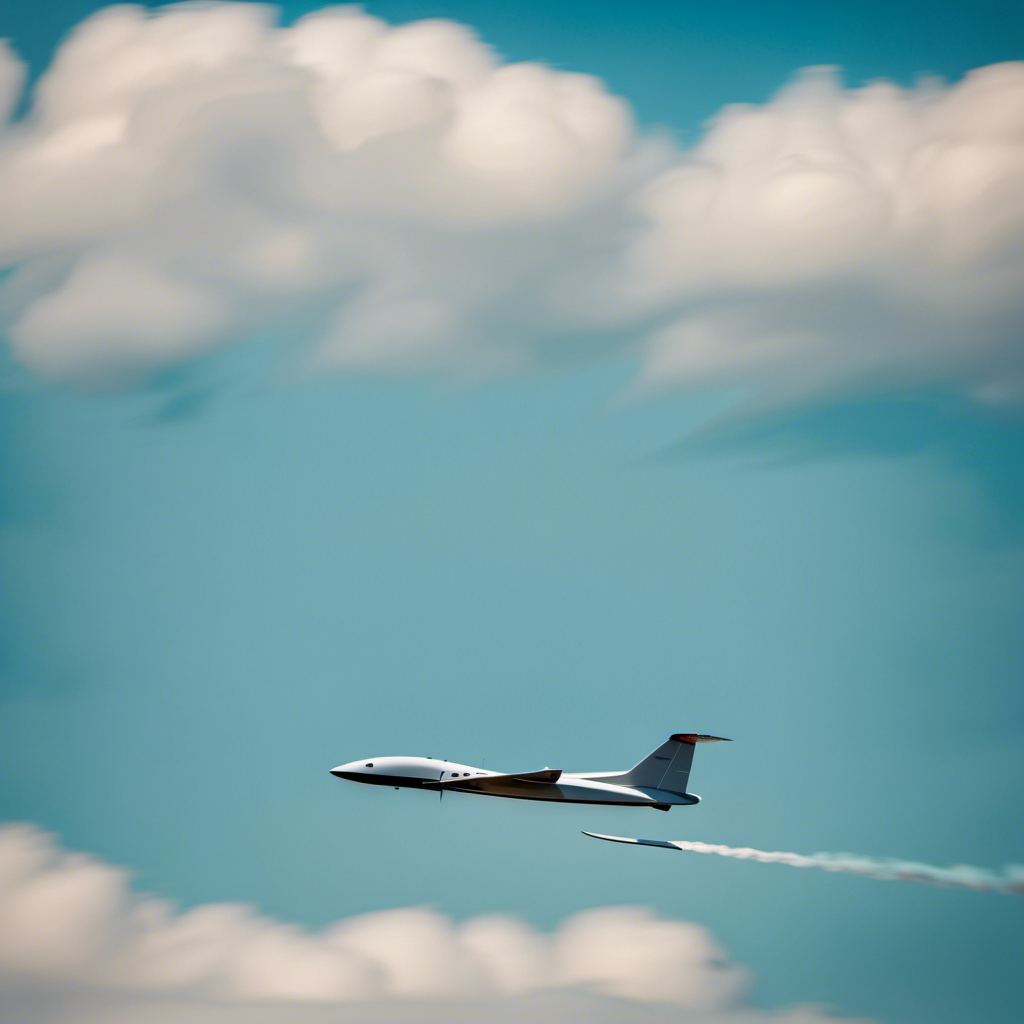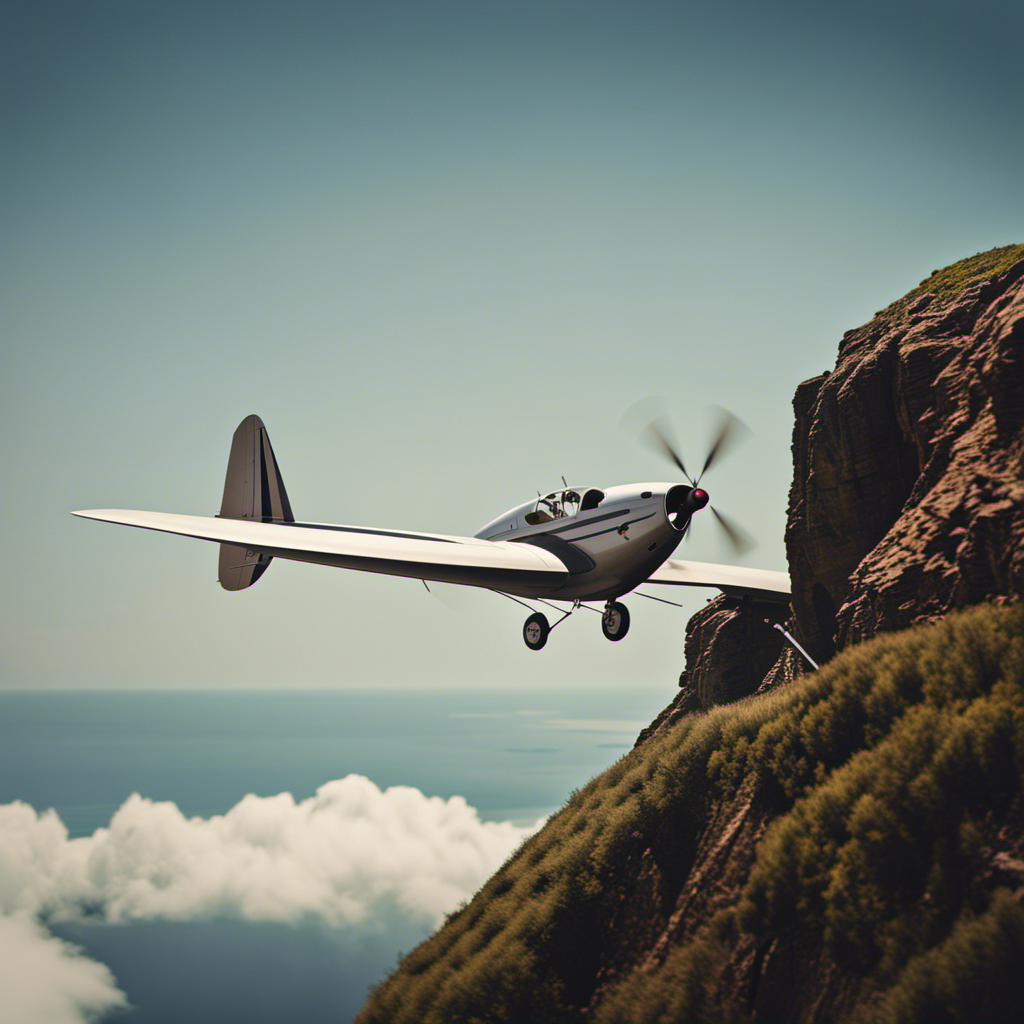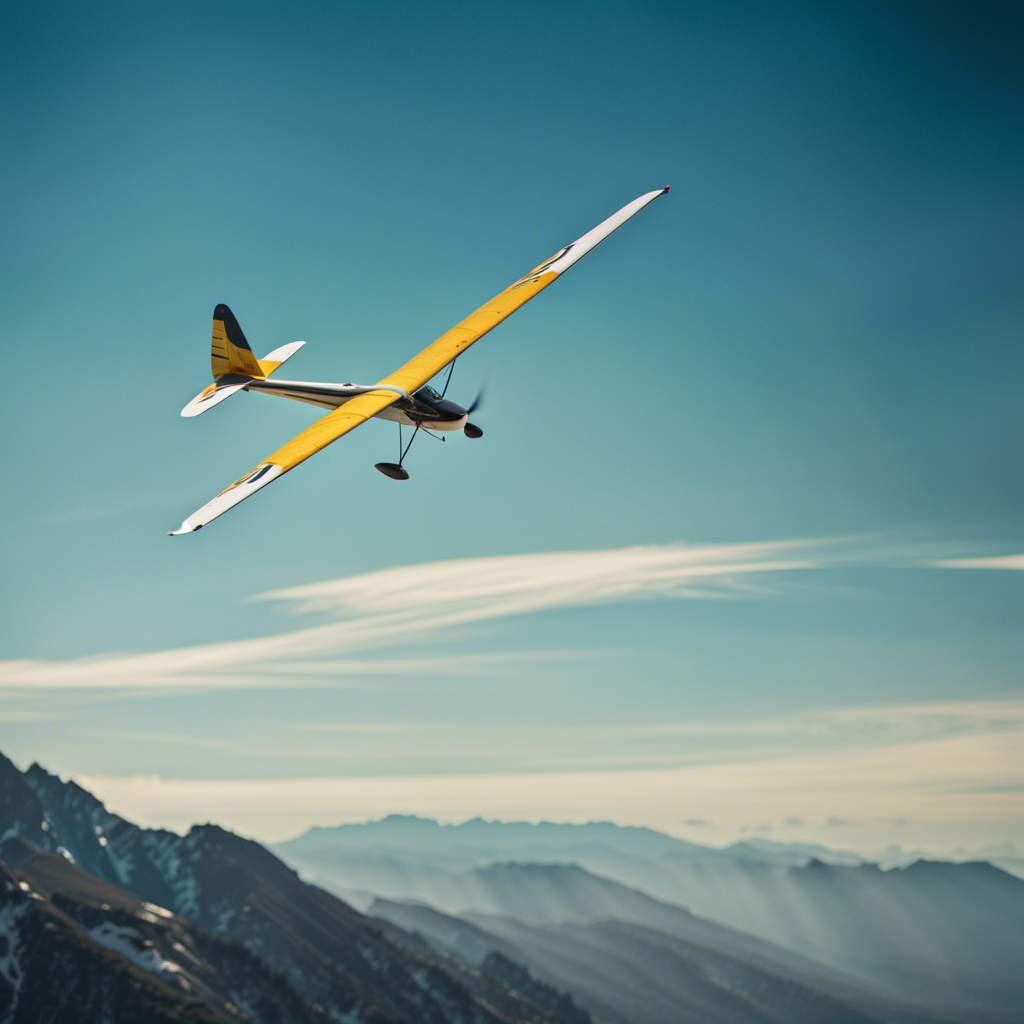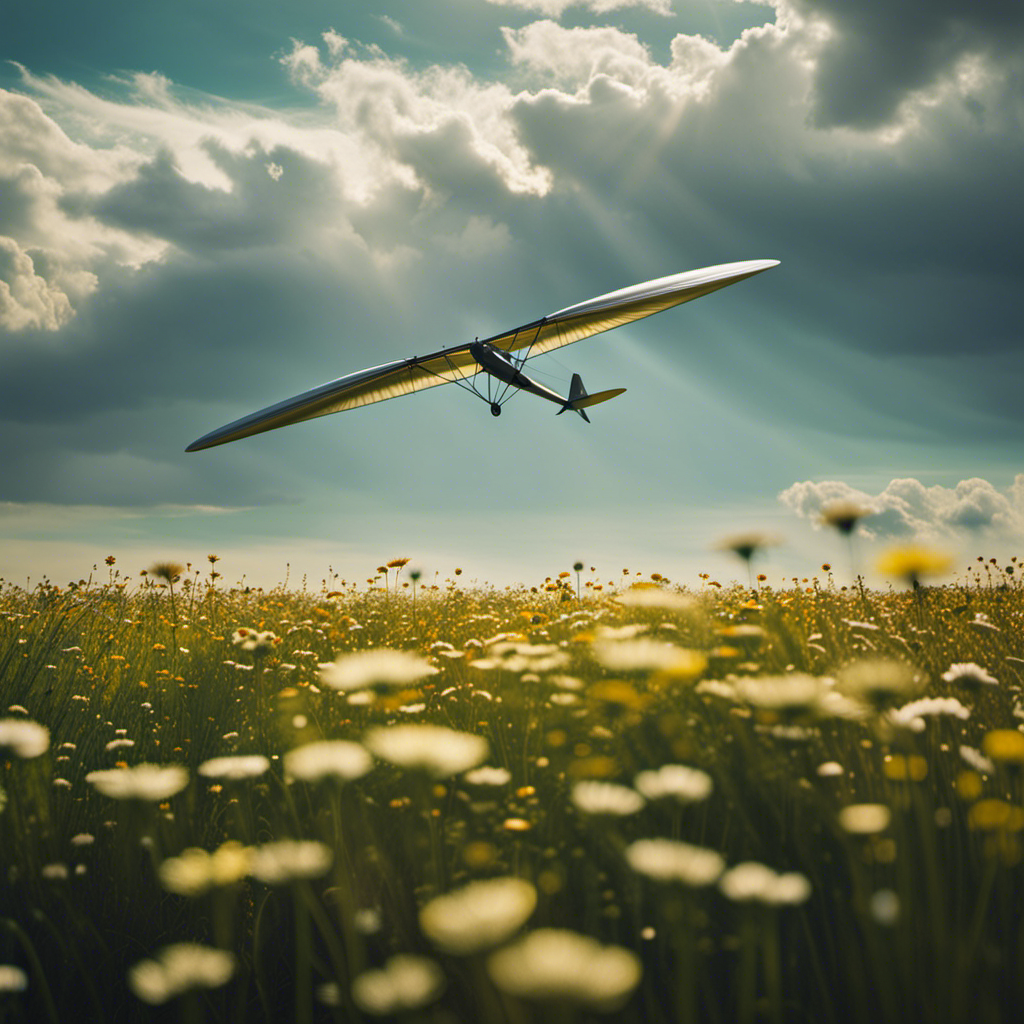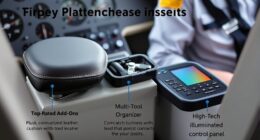As a glider pilot, I am constantly amazed by how these aircraft, which seem to have very little weight, are able to stay in the air. What allows a 500 kg glider to defy gravity and soar through the sky?
In this article, we will delve into the intricacies of glider design, explore the forces of lift and drag, and discover the techniques and skills that allow glider pilots to harness the power of the air.
Join me on this technical journey as we unravel the secrets behind this extraordinary feat of flight.
Key Takeaways
- Gliders are designed to maximize lift and minimize drag, with the shape of the wings generating lift by creating a pressure difference.
- Energy management techniques, such as altitude control and converting potential energy into kinetic energy, help maintain forward motion and maximize flight time and range.
- Glider piloting skills, including maneuvering into thermals and utilizing ridge lift, are crucial for sustaining flight.
- Safety considerations and advancements in glider technology, such as composite materials and instrumentation/avionics, enhance safety and performance during gliding.
The Basics of Glider Design
To stay up in the air, you’ll need to understand the basics of glider design. Glider aerodynamics and weight distribution play a crucial role in achieving flight.
Gliders are designed to maximize lift and minimize drag in order to maintain altitude. The shape of the wings, called the airfoil, is carefully designed to generate lift by creating a pressure difference between the upper and lower surfaces of the wing. This lift force counteracts the weight of the glider, allowing it to stay airborne.
Additionally, weight distribution is important for stability. By carefully placing the center of gravity, the glider can maintain a balanced flight path. Understanding these principles of glider design is essential for achieving sustained flight and maximizing performance.
Transitioning into the next section, let’s explore the forces of lift and drag that further contribute to glider flight.
Lift and Drag Forces
The lift and drag forces acting on a 500 kg glider are crucial for its ability to remain airborne. Lift generation is the upward force that counteracts the weight of the glider, allowing it to stay aloft. This force is created by the glider’s wings, which are designed to produce lift through the Bernoulli principle and the deflection of air downwards.
Drag, on the other hand, is the resistance encountered by the glider as it moves through the air. Minimizing drag is essential for maximizing the glider’s efficiency and range. Design features such as streamlined fuselage, smooth wing surfaces, and wingtip devices are employed to reduce drag.
Energy Management
By managing its energy efficiently, a glider can maximize its flight time and range. Energy efficiency is crucial in gliding as it allows the glider to stay airborne for longer periods. Altitude control plays a significant role in energy management. By carefully choosing the altitude, the glider can take advantage of updrafts and thermals to gain potential energy, which can then be converted into kinetic energy to maintain forward motion. This strategy helps the glider maintain a steady altitude and conserve energy.
Additionally, adjusting the glider’s pitch and airspeed can also optimize energy usage. These techniques enable the glider to efficiently convert potential energy into kinetic energy, effectively extending its flight time and range.
Transitioning to gliding techniques, there are various methods that glider pilots employ to further enhance their flight performance.
Gliding Techniques
Once you’ve gained enough altitude, you can utilize soaring techniques to extend your flight time and range. Glider aerodynamics play a crucial role in this process. By understanding how the glider interacts with the air, we can exploit natural phenomena such as thermals and ridge lift to stay aloft.
Thermals are columns of warm air that rise due to temperature differences. By circling within a thermal, the glider can gain altitude and continue its flight. Ridge lift, on the other hand, is generated when wind encounters an obstacle such as a mountain range. As the air is forced upward, the glider can take advantage of this upward flow to maintain its height.
Glider Piloting Skills
Transitioning seamlessly into the subsequent section, developing strong glider piloting skills is crucial to effectively utilize these techniques.
As a glider pilot, I understand the importance of understanding glider aerodynamics to stay airborne. To harness the power of thermals, I must master the art of detecting and exploiting these rising columns of warm air. By skillfully maneuvering my glider into the center of a thermal, I can gain altitude and extend my flight time.
Additionally, I must be adept at utilizing ridge lift, which occurs when wind encounters an obstacle, such as a mountain or a hill, and produces an upward force that can sustain glider flight. By skillfully positioning my glider along the ridge, I can harness this lift and soar effortlessly.
Transitioning into the subsequent section, weather factors and gliding conditions play a vital role in determining the success of a glider flight.
Weather Factors and Gliding Conditions
To effectively navigate the skies as a glider pilot, understanding the weather factors and gliding conditions is essential.
Weather has a significant impact on gliding performance, and being able to interpret and anticipate weather changes is crucial for a safe and successful flight.
There are several key weather factors that affect gliding, including wind speed and direction, temperature, humidity, and cloud cover. These factors can greatly influence the lift and sink experienced by the glider, as well as the availability of thermals and other sources of lift.
By analyzing these weather factors, a glider pilot can make informed decisions about when and where to fly, maximizing their gliding performance.
Now, let’s move on to the next section and explore the important safety considerations in glider piloting.
Safety Considerations
Transition: Now that we understand the various weather factors affecting gliding conditions, it is essential to delve into the safety considerations involved in operating a glider.
Current Subtopic: Safety Considerations
- Emergency Procedures: In the event of an emergency, glider pilots must be well-versed in emergency procedures to ensure the safety of both themselves and any passengers on board.
- Maintenance Requirements: Regular maintenance and inspections are crucial to ensure the glider is in optimal condition and safe to fly.
- Pilot Training: Pilots must undergo rigorous training to acquire the necessary skills and knowledge to handle emergency situations and mitigate risks.
- Safety Equipment: Gliders are equipped with safety devices such as parachutes, emergency locator transmitters, and fire extinguishers to enhance safety during flights.
- Risk Assessment: Thorough risk assessment and management practices are employed to identify potential hazards and implement preventive measures.
Transition: By carefully considering these safety aspects, we can now explore the advancements in glider technology that have revolutionized the field.
Advancements in Glider Technology
As a glider pilot, I am constantly amazed by the advancements in glider technology.
Three key areas that have seen significant progress in recent years are:
-
Composite materials: Composite materials, such as carbon fiber, have revolutionized glider construction. They provide strength, durability, and weight reduction, making gliders more efficient and maneuverable.
-
Winglets and wingtip devices: Winglets and wingtip devices have improved glider performance. By reducing drag and increasing lift, they enhance the glider’s aerodynamics, allowing for longer and more efficient flights.
-
Instrumentation and avionics: Advancements in instrumentation and avionics have transformed the way glider pilots fly. With real-time data and advanced navigation systems, pilots have access to vital information for enhanced safety and efficiency during their flights.
These advancements in composite materials, winglets and wingtip devices, and instrumentation and avionics have greatly contributed to the progress of glider technology. They have made gliders more capable, reliable, and enjoyable to fly.
Composite Materials
You can understand how a 500 kg glider stays up in the air by considering the use of composite materials. These materials, made from a combination of different substances, offer immense strength and lightness, critical factors for glider performance.
Composite materials, such as carbon fiber reinforced polymers, provide the necessary rigidity to withstand the forces experienced during flight, while keeping the overall weight of the glider to a minimum. This not only enhances the glider’s maneuverability and efficiency but also contributes to sustainability practices by reducing fuel consumption.
With composite materials, glider manufacturers can create structures that are both durable and environmentally friendly.
Transitioning to the next section, winglets and wingtip devices further optimize glider performance and efficiency without compromising safety.
Winglets and Wingtip Devices
To enhance the performance and efficiency of your glider, winglets and wingtip devices are essential components.
Winglets are vertical extensions at the end of the wings, while wingtip devices refer to various devices attached to the wingtips.
These components work by reducing the wingtip vortices, which are formed due to the pressure difference between the upper and lower surfaces of the wings.
By minimizing these vortices, winglet efficiency is improved, leading to reduced drag and increased lift.
This results in better fuel efficiency and improved overall performance of the glider.
As we transition into the next section about instrumentation and avionics, it is important to note that these devices work in conjunction with advanced technologies to optimize the glider’s performance.
Instrumentation and Avionics
Transitioning from the discussion on winglets and wingtip devices, it is important to explore the role of instrumentation and avionics in enabling a 500 kg glider to stay airborne.
Instrumentation advancements and avionics technology have revolutionized the way gliders are equipped and operated. Here are three key contributions they make:
-
Flight Data Monitoring: Advanced instruments now provide real-time data on airspeed, altitude, and attitude, allowing pilots to make precise adjustments and optimize their performance.
-
Navigation Systems: GPS and other navigation aids help glider pilots determine their position, plan routes, and navigate through varying wind conditions.
-
Safety Systems: Avionics technology has introduced features like collision avoidance systems, stall warning indicators, and emergency locator transmitters, enhancing safety during flights.
With these advancements, glider pilots have access to crucial information and safety measures that enable them to compete and set new records in glider competitions, without relying on powered engines.
Glider Competitions and Records
Cross-country flying, speed and distance records, and world gliding championships are all integral aspects of glider competitions.
In cross-country flying, pilots navigate through varying terrain and weather conditions, relying on their skills to maximize distance covered.
Speed and distance records, on the other hand, showcase the remarkable capabilities of gliders, pushing the boundaries of what is possible.
Cross-country Flying
Flying cross-country requires careful planning and navigation to ensure a safe and successful journey. When flying a glider, it is crucial to take advantage of natural sources of lift, such as thermals and ridge soaring, to maintain altitude and cover long distances.
Thermals are columns of warm air that rise due to temperature differences, while ridge soaring involves flying along the upwind side of a hill or mountain, using the upward air currents generated by the wind hitting the slope. These techniques allow the glider to gain altitude and travel further without the need for an engine.
In addition to utilizing thermals and ridge soaring, accurate navigation techniques are essential for cross-country flying. Pilots rely on instruments like GPS and maps to determine their location, plan their route, and make necessary adjustments during the flight.
Speed and Distance Records
To set speed and distance records, you’ll need to carefully plan your route, utilize natural sources of lift, and rely on accurate navigation techniques.
Achieving speed records in gliding requires finding optimal weather conditions, such as strong thermal updrafts and ridge lift. By skillfully exploiting these natural sources of lift, gliders can maintain high speeds and cover long distances. Additionally, altitude records can be achieved by seeking out areas with powerful wave lift, which can propel gliders to extreme heights.
Accurate navigation techniques, such as using GPS systems and visual markers, are crucial for maintaining a precise course and maximizing speed. With meticulous planning and skillful execution, glider pilots can push the boundaries of speed and distance in their pursuits.
Transitioning into the subsequent section about the world gliding championships, pilots who excel in these endeavors have the potential to compete on a global stage.
World Gliding Championships
For the World Gliding Championships, you’ll need to showcase your skills in navigating challenging routes and making strategic decisions to outperform other pilots. The key to success in these championships lies in understanding glider performance and optimizing every aspect of your flight. From selecting the right glider with the best glide ratio to mastering thermals and exploiting wind patterns, every detail counts. To illustrate the importance of glider performance, consider the following table:
| Glider Aspect | Performance Impact |
|---|---|
| Glide Ratio | Determines distance covered for a given altitude loss |
| Wing Loading | Affects maneuverability and responsiveness |
| Wing Span | Influences lift and stability |
| Drag Coefficient | Determines air resistance and speed potential |
| Weight | Affects climb rate and overall performance |
The Future of Gliding
As we explore the future of gliding, it is crucial to discuss the advancements in electric and hybrid gliders. These aircraft utilize sustainable and eco-friendly practices, reducing their carbon footprint and promoting environmental consciousness.
Additionally, gliding as a recreational activity aligns perfectly with the growing demand for sustainable leisure pursuits, allowing enthusiasts to experience the thrill of flying while respecting the planet.
Electric and Hybrid Gliders
Electric and hybrid gliders are becoming more popular in the aviation industry. With advancements in electric propulsion and battery technology, these gliders are capable of flying without the need for a traditional combustion engine.
Electric propulsion systems, which are powered by batteries, provide a clean and efficient source of energy for gliders. These systems offer numerous advantages, such as reduced noise, lower maintenance costs, and improved environmental sustainability.
Additionally, hybrid gliders combine electric propulsion with a small combustion engine, allowing for extended flight durations and increased flexibility.
As the demand for sustainable and eco-friendly practices in aviation continues to grow, electric and hybrid gliders are paving the way for a greener future in the industry. Transitioning towards these innovative technologies is a significant step towards achieving a more sustainable and environmentally conscious aviation sector.
Sustainable and Eco-friendly Practices
You can contribute to a greener future in the aviation industry by adopting sustainable and eco-friendly practices.
One way to achieve this is by utilizing solar powered gliders, which harness the power of the sun to generate electricity and reduce carbon emissions. Solar powered gliders are equipped with photovoltaic panels that convert sunlight into energy, providing an environmentally friendly alternative to traditional fuel-powered aircraft. By relying on renewable energy sources, these gliders significantly decrease their carbon footprint, making them a more sustainable choice for aviation enthusiasts.
In addition to solar power, other sustainable practices such as minimizing waste, using biodegradable materials, and implementing energy-efficient technologies can further contribute to a greener aviation industry.
Transitioning into the subsequent section, gliding as a recreational activity offers a unique and environmentally conscious way to experience the thrill of flight.
Gliding as a Recreational Activity
Transitioning into the subsequent section, gliding as a recreational activity offers a unique and environmentally conscious way to experience the thrill of flight.
Glider maintenance is a crucial aspect of ensuring the safety and performance of these aircraft. Regular inspections, repairs, and replacements of various components, such as the wings, control surfaces, and landing gear, are essential to keep the glider in optimal condition.
Additionally, glider clubs play a significant role in maintaining and promoting the sport. These clubs provide a platform for glider enthusiasts to come together, share knowledge, and organize events. They also offer training programs and resources for pilots to enhance their skills.
Frequently Asked Questions
How long can a 500 kg glider stay in the air without any external assistance?
A 500 kg glider can stay in the air without external assistance for several hours, depending on weather conditions and the pilot’s skill. Regular glider maintenance and inspections are crucial for safe and efficient performance in long distance glider competitions.
What are the legal requirements for operating a glider?
To operate a glider, legal regulations must be followed, which include adhering to safety measures. These regulations ensure the safe operation of gliders, protecting both the pilot and others in the airspace.
How are glider pilots trained and certified?
Glider pilot training involves both theoretical and practical instruction to ensure competence in various maneuvers and emergency procedures. Certification is granted after passing written exams, flight tests, and meeting minimum flight hour requirements.
What are the potential risks associated with gliding?
The potential risks associated with gliding involve safety concerns. These include factors such as weather conditions, equipment failure, pilot error, and mid-air collisions. Safety measures should be implemented to mitigate these risks.
Can a glider be equipped with any type of propulsion system?
A glider can be equipped with a propulsion system, which enhances its glider performance. This allows the glider to have better control and maneuverability, resulting in improved flight capabilities.
Conclusion
In conclusion, the remarkable ability of a 500 kg glider to soar through the sky is a result of meticulous glider design, skillful piloting, and cutting-edge technology.
By harnessing the power of lift and managing drag forces, gliders can achieve and maintain flight. Energy management techniques and precise piloting skills further enhance their performance.
Safety considerations and advancements in glider technology continue to push the boundaries of what is possible in gliding. Glider competitions and record-breaking feats showcase the immense potential of this soaring sport.
The future of gliding holds endless possibilities for further innovation and exploration in the skies.
With a heart that soars as high as the skies, Aria, affectionately known as “Skylark,” is the driving force behind Soaring Skyways. Her journey into the gliding world began as a young dreamer gazing up at the soaring birds, yearning to experience the weightlessness and freedom they embodied. With years of experience both in the cockpit and behind the scenes, Aria’s commitment to the gliding community is unwavering.
